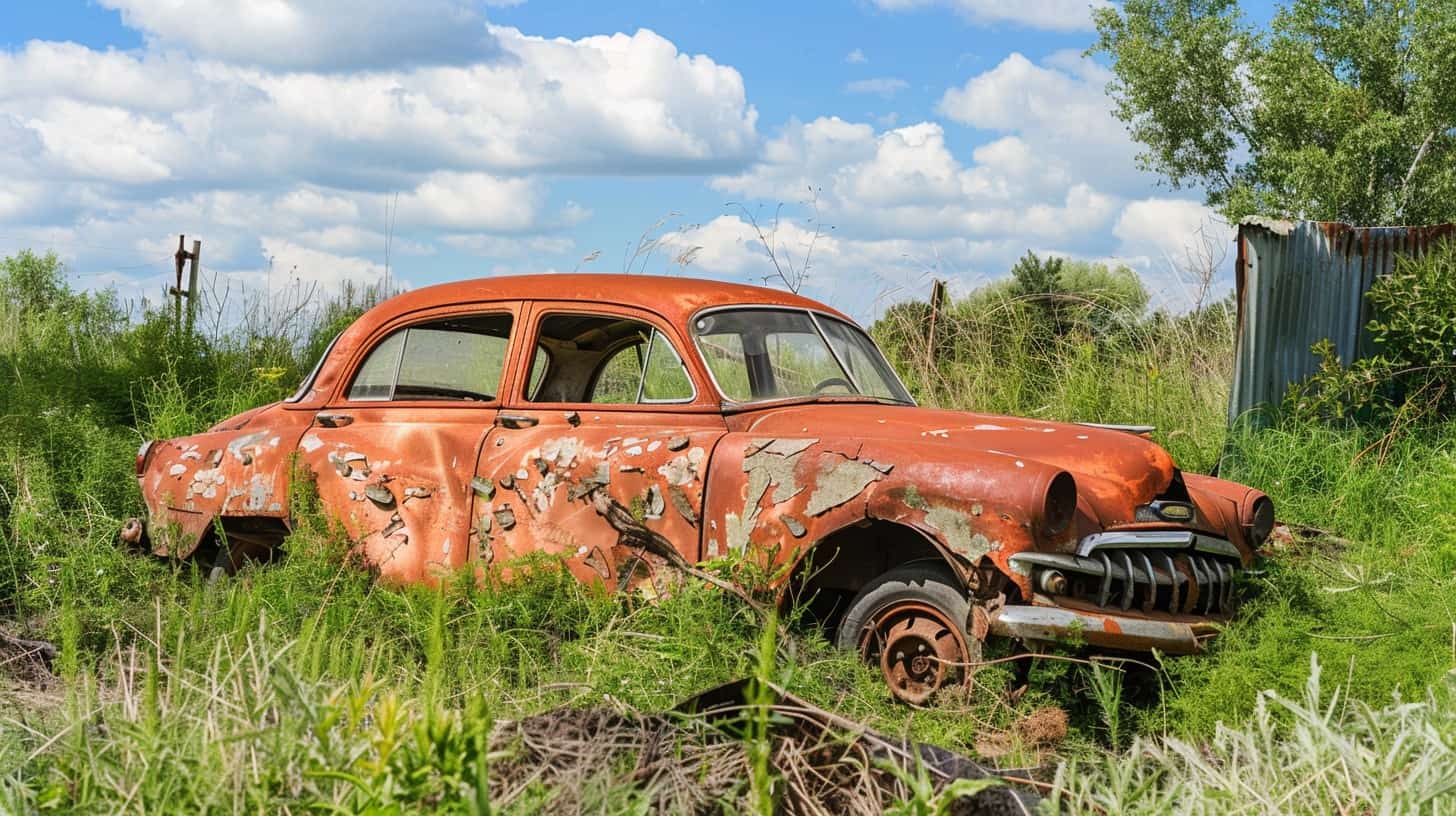Deciding to junk a car is tough. Graduating or starting a family often signals this need. This post outlines five signs indicating it’s time—to help you make an informed choice.
Read on for insights.
Key Takeaways
If fixing your car costs more than its value, it’s time to consider junking it.
Cars without modern safety features pose higher risks on the road.
Frequent check engine lights suggest serious problems that could be expensive to fix.
Rust and body damage weaken your car’s structure and lower its value.
Selling or trading a damaged or high-mileage car can be challenging, making junking a practical option.
Table of Contents
Recognizing When to Junk Your Car
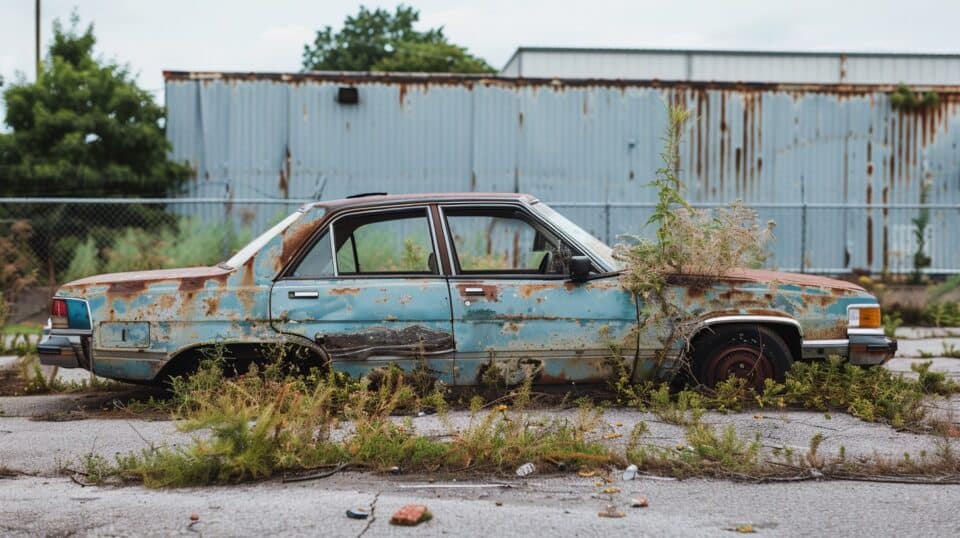
Knowing when to junk your car is key. Right before I left Queens, New York, for a new state, I sold my old ride to one of the many Queens junkyards.
Excessive Repair Costs Versus Car Value
Excessive repair costs often signal it’s time to junk your car. If maintenance bills exceed your vehicle’s trade-in value, consider letting go. Here’s a breakdown in table format:
| Factor | Detail |
|---|---|
| Car Value | Assess current market value of your vehicle. |
| Repair Costs | Calculate recent and upcoming maintenance expenses. |
| Comparison | Compare repair costs against car value. If repairs cost more, it’s time to junk. |
| Safety Risks | Older cars with high repair costs pose safety risks, influencing the decision. |
| Selling Challenges | If selling or trading in seems difficult due to these costs, junking might be optimal. |
When repairs become a frequent need, your safety and wallet are at risk. Cars with excessive upkeep costs often face selling challenges, making junking a practical choice. High maintenance bills can overshadow the worth of your vehicle, leading to a more reliable, cost-effective alternative. Junking your car might be the smart move, especially when its market value dips below the cost to keep it running.
Safety Risks in Older Vehicles
Older vehicles lack new safety features. They miss out on side airbags and electronic stability control. These tools prevent crashes and protect against accidents. Cars without them are not as safe.
Safety ratings drop over time for used cars. A high rating years ago doesn’t mean a car is safe now. New technology in automobiles makes driving safer today than ever before.
The next sign to look for involves frequent check engine alerts, signaling deeper issues under the hood.
Driving an older vehicle without modern safety features is like sailing a boat with no life jackets—it’s unnecessarily risky.
Frequent Check Engine Alerts
The check engine light turns on for a reason. It’s your car telling you something is wrong with its heart— the engine. If this warning pops up often, don’t ignore it. Frequent alerts can mean problems ranging from minor issues like a loose gas cap to major concerns such as a failing emission system or faulty auto parts that need immediate attention.
This constant signaling is not something to put off with duct tape repairs; it hints at underlying issues that could be costly.
Seeing the check engine light often? It’s time to take action before small fixes become big bills. Regular trips to mechanics for diagnostics and dealing with recurring engine light issues might lead you to cash auto salvage options sooner than expected, especially if repair costs soar beyond what your vehicle is worth in marketplaces like kbb.com or auctions on eBay Motors.
This persistent problem affects your driving safety too, making every trip uncertain because of possible breakdowns or emissions failures; thus, junking as an eco-friendly vehicle solution, aligning with recycling industry practices for old cars no longer reliable for safe journeys.
Severe Rust and Body Corrosion
Moving on from engine alerts, rust, and body corrosion are critical too. Rust eats your car’s body over time. It’s not just an eyesore—it weakens your car’s structure. If you see large rust spots or holes in the car body, it’s a sign of severe deterioration.
Cars with bad rust might fail emissions tests because their exhaust systems get damaged.
Selling such a car becomes tough. Scrapyard or salvage yard visits become necessary when corrosion takes over. Safety risks rise as the vehicle’s strength decreases due to rusting parts like seatbelts and key structural elements getting affected.
Also, fixing this issue can cost more than the car’s worth—making scrapping a wise choice here for sure.
Challenges in Selling or Trading Your Vehicle
Rust and body damage leads straight into another big problem: selling or trading your car can be tough. Dealerships often say no to cars with a salvage title or ones that look like they’re held together by duct tape.
They know these cars don’t attract buyers. If you try to sell on your own, expect lots of “no thanks” once they see the condition.
Selling parts from your car might seem like a plan – especially if it has an OEM part still in good shape. Yet, finding buyers takes time and effort. And if your car didn’t come with a title, that’s another hurdle.
People worry about insurance fraud and legal issues without proper paperwork. In short, getting cash for a junked vehicle isn’t as easy as ads make it seem – even if they offer free towing.
Assessing Your Car’s Overall Condition
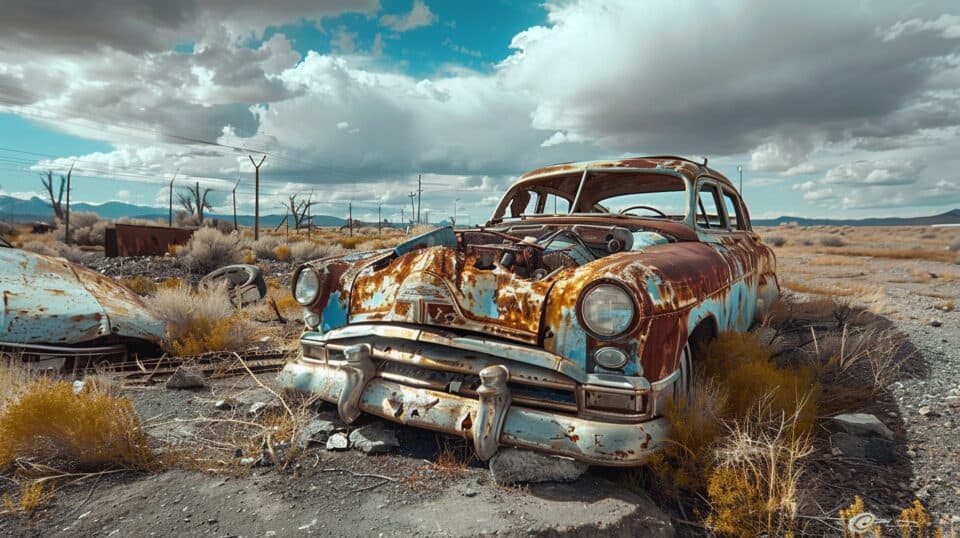
Checking your car’s health is key. Look at how often it breaks and the shape of its body.
Frequent Mechanical Breakdowns
Cars break down; it’s a fact of life. But if your car stops running often, it’s telling you something big. Each visit to the mechanic for repairs can drain your wallet quickly. Especially when the cost of fixing your car engine or dealing with another breakdown adds up to more than what your car is worth on Kelley Blue Book.
Frequent breakdowns signal the end is near for your vehicle.
These constant issues mean bigger problems beyond just inconvenience—they pose serious questions about reliability and safety. Imagine being stranded on the side of a road because that “check engine” light was a sign from God after all, warning you of an impending total loss situation.
Breakdowns aren’t just frustrating; they are red flags waving at you, suggesting that investing more money might be like duct-taping a sinking ship—ineffective and temporary.
A high-mileage gas-guzzler breaking down repeatedly isn’t only bad for your schedule but also hits hard financially. Insurance companies might raise premiums as auto insurance becomes pricier with each incident report or claim filed due to these mechanical failures.
It makes less sense to pour money into such a bottomless pit when fuel-efficient, electric cars await with rebates and lower carbon footprints.
So, count those frequent visits—the ones where invoices stack up—and ask yourself if it’s worth holding onto this recycled dream any longer.
Extensive Body Damage
Cars with major body damage are often beyond simple repairs. If your car is “rusty” or was in a big accident, fixing it might cost more than the car is worth. This damage could be deep scratches, large dents, or parts that don’t fit right anymore.
Such conditions lower your vehicle’s resale value drastically.
Selling a damaged car can be hard. People usually don’t want cars that have been in serious collisions or have severe rust. You might think about going to a scrap yard. Here, they recycle cars for parts and metal.
This way, you get some money back instead of paying for costly fixes.
High Mileage and Low Fuel Efficiency
Cars hitting 150,000 miles show signs of wear and tear. This milestone suggests your car is nearing the end of its life. It’s a clear signal to start thinking about vehicle recycling options.
At high mileage, cars often lose their fuel efficiency, too. They consume more gas for each mile traveled than they did when new. This decline in performance increases costs at the pump and signals deeper issues under the hood that can be expensive to fix.
These cars fail to meet modern emission standards easily, making them less eco-friendly choices on the road. Opting for a newer model could save you money on fuel and repairs long-term while ensuring you’re driving a safer, more reliable vehicle.
Selling your car for parts or trading it in might seem challenging due to these factors, but vehicle recycling centers often offer cash deals regardless of condition—turning your high-mileage car into an opportunity rather than a burden.
Financial Factors to Consider Before Junking Your Car
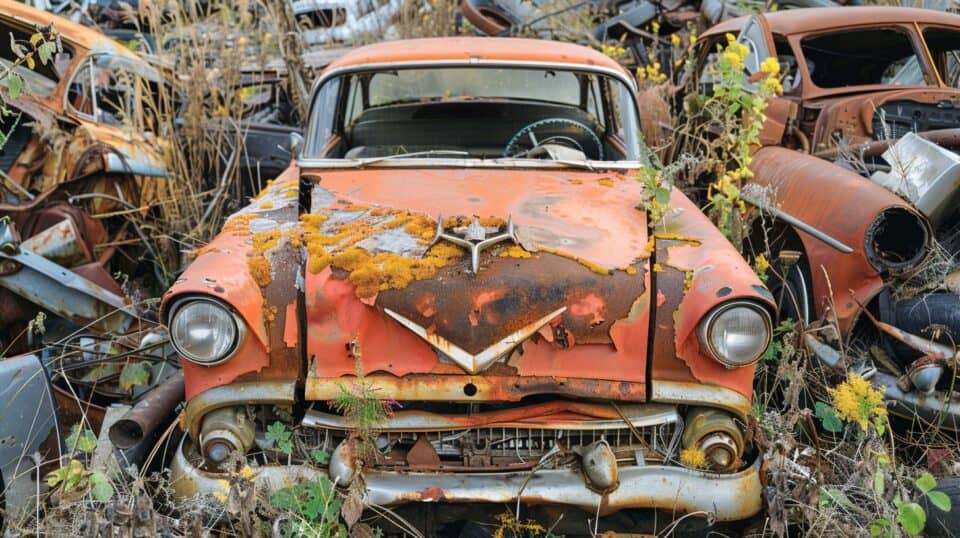
Money talks, especially when deciding if it’s time to let your old ride go. Check how much fixing it will cost versus getting a new one, look at what you pay to insure an older car, and think about the cash you could get from selling it as parts.
Comparing Repair Costs with Vehicle Replacement
Deciding between fixing your car and getting a new one involves simple math and safety considerations. Here’s a breakdown in a handy table format, focusing on comparing repair expenses with the cost of vehicle replacement:
| Aspect | Repair Costs | Vehicle Replacement |
|---|---|---|
| Initial Financial Outlay | Varies, can be high after major accidents | Significantly higher but a long-term investment |
| Value | May exceed car’s current market value | New or pre-owned vehicle retains value better |
| Safety | Older vehicles might pose risks | Newer models come with advanced safety features |
| Insurance Premiums | Can increase for older, frequently repaired cars | May decrease with purchase of newer, safer models |
| Long-Term Costs | Continued repairs add up over time | Initial higher cost, but lower maintenance expenses |
Fixing a car might seem less expensive upfront. Yet, when costs exceed the trade-in value, it’s time to think ahead. Newer cars offer safety, efficiency, and peace of mind. If repairs keep your savings account empty, consider a replacement. It’s not just about cost. It’s about value, safety, and reliability. Every dollar spent on an aging car could go to a reliable, efficient model. Make a smart choice. Your safety and financial well-being depend on it.
Insurance Premiums for Aging Cars
Insurance companies often charge more to cover older vehicles. This is because aging cars can have more problems and might need costly repairs after a car accident. The cost of repairs for these vehicles can sometimes be as much as their worth.
As your car gets older, its value goes down, but insurance premiums don’t always drop at the same rate.
Keeping an old car means paying these high premiums without getting the full benefits if something goes wrong. It’s clear: over time, you could end up spending more on insurance than what your used car is worth.
Always check how much you’re paying to insure your aging vehicle against its current price and consider if it’s time to move on.
Revenue from Selling Your Car for Parts
After considering the cost of insurance premiums for older cars, selling your car for parts emerges as a smart financial move. Junkyards readily offer cash for vehicles, even those past their prime.
This method provides an immediate return on a car that would otherwise cost more to maintain than it’s worth. By breaking down your vehicle into parts, you stand to make money from components like the engine, transmission system, and even smaller items such as license plates.
Selling pieces individually can sometimes yield more cash than selling the whole car at once. I’ve seen engines sold for hundreds of dollars, while transmissions fetched similar amounts.
Even worn-out license plates have found new lives as decorative items or collector’s pieces, bringing in more revenue than expected. It’s a straightforward process: receive and accept a cash offer from a salvage yard; they handle most of the heavy lifting.
Turning your old car into spare parts is recycling at its best—both eco-friendly and economically wise.
Steps to Junk Your Car
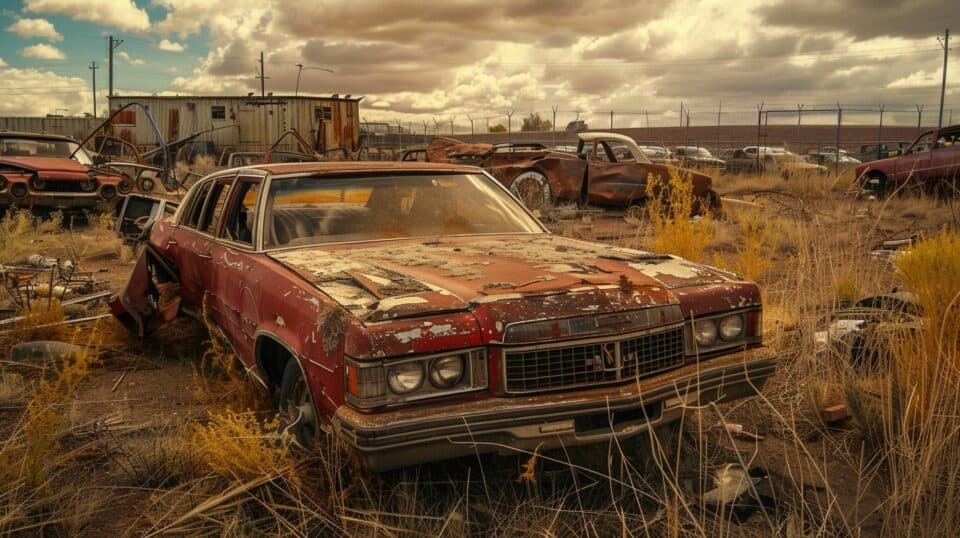
To junk your car, find a salvage yard or look online for cash offers. You might also consider giving it away to get a tax break. Ready to learn more?
Options for Selling to a Salvage Yard
Selling your car to a salvage yard is straightforward. You get rid of your old car and make some cash quickly. Here’s how:
- Gather all necessary vehicle information like year, make, model, and condition. Salvage yards need these details to give you an accurate offer.
- Call different salvage yards for quotes. Prices can vary widely, so it pays to check a few places.
- Confirm they offer free towing. Most reputable yards will pick up your vehicle at no extra charge.
- Choose a pickup date that works for you. Salvage yards are typically flexible with scheduling.
- Prepare your car for pickup. Remove all personal items and any valuable parts you want to keep if allowed.
- Complete the sale with proper paperwork. You’ll usually need your ID and the car title.
- Get paid on the spot when they tow away your car.
This process allows you to swiftly transition from an unwanted vehicle to extra funds in your pocket without hassle or delay.
Exploring Online Cash Offers
Getting cash for your car online is easy and fast. Websites like Cash Auto Salvage give free instant offers, making it simple to see how much you can get.
- Visit a cash offer website.
- Enter your car’s details – make, model, year, and condition.
- Get an instant cash offer online.
- Accept the offer if it meets your expectations.
- Arrange for free car pickup from your location.
- Receive cash quickly, often on the same day as pickup.
This process removes the hassle of selling or trading in your old car. It’s direct and gets you money fast without leaving home.
Donating Your Car for a Tax Deduction
Donating your car brings a dual benefit. You support a cause and get a tax deduction.
- Choose a charity that accepts vehicle donations.
- Verify the organization is recognized by the IRS for tax deductions.
- Clean out your car, removing all personal items.
- Transfer the title to the charity, ensuring you sign it over properly.
- Keep detailed records of the donation for your taxes, including a receipt from the charity.
- Itemize your tax return to claim the deduction, using IRS Form 1040.
- Determine your car’s fair market value if it’s under $500 or use the amount stated by the charity if they sell it.
- Report any additional income received from the sale of the vehicle above $500 on Form 1098-C.
- Consult with a tax professional to maximize your benefits and ensure accuracy in filing.
This approach ensures you give back and save on taxes effectively.
People Also Ask
How do I know if my car is too old to keep?
If your car’s age makes it more of a relic than a ride, it’s time.
What if fixing my car costs more than it’s worth?
When repair bills soar higher than your car’s value, junk it.
Are frequent breakdowns a sign to junk my car?
Yes, constant breakdowns mean your car’s saying goodbye.
Should I sell my car if it’s unsafe to drive?
Absolutely, safety first—junk that hazard on wheels.
Is bad fuel efficiency a reason to consider junking my car?
Sure thing, when gas-guzzling gets out of hand, let go.
